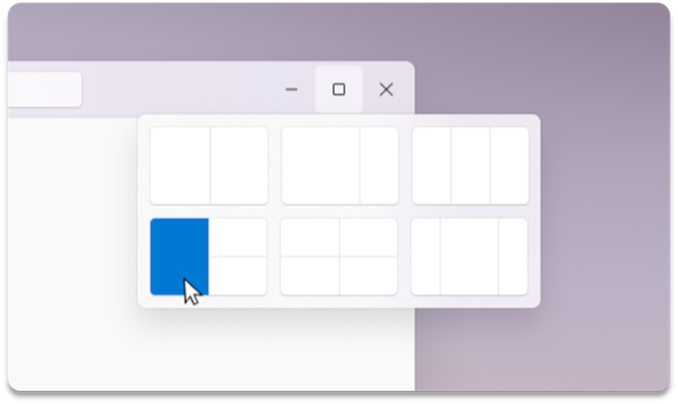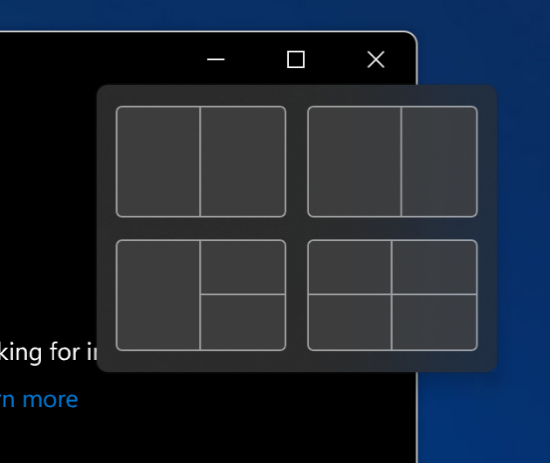What to Expect with Windows 11: A Day One Hands-On
by Brett Howse on October 4, 2021 4:00 PM EST- Posted in
- Software
- Operating Systems
- Windows
- Microsoft
- Windows 11
Improved Docking And Snap Layout Experiences
Multi-monitor laptop users rejoice. Microsoft has finally addressed the frustration that is docking and undocking in Windows with an improved experience. It seems crazy that in 2021, Windows 10 still makes a complete mess of the desktop layout when docking and undocking a laptop from a monitor or multiple monitors, but that is indeed the case. In Windows 10, if you have a laptop connected to any number of external monitors, if you undock, all of your open applications will be moved to and resized onto your laptop display. Then, if you reconnect to the external display, you get the wonderful task of moving all of your applications back and resizing them. With Windows 11, the operating system will finally remember where everything was, and put it back automatically.
 Snap options on a large display
Snap options on a large display
If you are a user of the current Windows Snap functionality, where you can drag an open window to the side or corner of the display and then snap another application beside it, you will be happy to see the improvements to snap functionality. If you had no idea this existed, because the discoverability of dragging an open application to the side of your display is a non-obvious task, you will be even happier to see that Microsoft has greatly improved the discoverability of Snap by adding it to the maximize button on any open window.

Snap Options on a small display
Hovering over the maximize button will now provide a graphics representation of different options to snap one or more applications to different locations on the display, and the choices will depend on the size and resolution of the display in question so that you don’t end up with a selection that does not leave enough of an open window usable.
You can now easily snap up to four applications open at once and choose how they are arranged with far less difficulty than Windows 10.
Security Changes
Likely one of the most controversial changes to Windows 11 is the requirement for a trusted platform module (TPM) to be active in the system. Microsoft is now requiring TPM 2.0, and this is a major hurdle for a lot of older devices. Microsoft has stated that “Most PCs that have shipped in the last 5 years are capable of running Trusted Platform Module version 2.0” which is a true statement, but for it to be true that only means that over 50% of computers have TPM 2.0. It is a vague statement and is likely driven by laptop sales outpacing desktop sales.
The requirement for TPM 2.0 does allow Microsoft to enable security features that they had previously supported, but never enabled by default such as Virtualization-Based Security (VBS). VBS can be implemented without a TPM, but it is highly recommended to have one, and in an age of phishing, malware, and ransomware, it makes sense to want to enable all of the security features that you can. The communication of this change was not very clear though, and this single requirement is going to impede the rapid adoption of the new OS.
Windows 11 is also very stringent on its CPU requirements. Intel processors basically have to be 8th generation (Coffee Lake) or newer, with AMD processors needing to be 2nd generation Ryzen (Zen+) or newer. For a full list of the supported processors, you can check out the information on Microsoft’s support page: https://docs.microsoft.com/en-us/windows-hardware/design/minimum/windows-processor-requirements










95 Comments
View All Comments
Peter2k - Tuesday, October 5, 2021 - link
Gotta remember the Windows 10 credo back then"Windows everywhere"
Means PC, XBOX and phones
Since that failed I guess the new direction is to clamp down on security
While you could have all the security on 10, 11 is enforcing it
Guess they try to go after big business bucks
I'm on a first Gen Ryzen, not gonna upgrade just because I could force it
For what really
It looks a bit prettier, and sounds a bit prettier
That isn't weigh for me as a private person to upgrade the OS, and especially not to build a new rig
Personally I think the getting "Windows crammed into everything anywhere " isn't this generations motto at all
It's more, take it or leave it
Also keep in mind Windows terrible history/cycle
One OS is great, next one is trash
Hasn't been broken yet
While 11 might not be trash, it could very well be under performing for adoption
griffin_short - Tuesday, October 5, 2021 - link
Exactly. Just release a massive UI overhaul for Windows 10 rather than launching a whole new OS.dullard - Tuesday, October 5, 2021 - link
EcoQoS and enhanced PowerThrottling API are why. Just about every Windows 11 app was recompiled for lower power usage compared to Windows 10, this will be especially true when Alder Lake comes out.croc - Tuesday, October 5, 2021 - link
They REALLY NEED to get a better typeface....The current one is too 'light' for weaker eyes to not have to strain, causing some to have headaches after LONG usage times.The loss of Win 10's start-up 'groups' can be solved by making folders and copying (or creating) shortcuts inside. For instance, a folder called 'Office' with the various shortcuts inside.
Really, this is more about new paint as it is about a better OS
beginner99 - Tuesday, October 5, 2021 - link
The fact you can't change the taskbar location is just one small things about how the taskbar is now almost useless and productivity will be heavily impacted.Like the claimed improved multi-monitor support but yet the new taskbar only show the clock on the primary monitor which when in full screen-mode means no clock visible. It's a 1 step forward 2-steps back situation really.
voicequal - Tuesday, October 5, 2021 - link
I'm guessing they'll add the taskbar location option, since almost every Win11 article seems to mention it as a deficiency. This seem like a minimum viable product. Time will tell how fast features will be added to fill in the rough spots.damianrobertjones - Tuesday, October 5, 2021 - link
Installs Windows 11 onto a Surface Book. Installs applications while changing a few configuration options. launches applications. Continues as normal.No issues here. Then again, I'm not LOOKING for a reason to moan and complain. It still does what it should do (mostly).
incanter - Tuesday, October 5, 2021 - link
If your Surface Book had 16:9 screen, you might be more tolerant to "moans and complaints" about inability to move taskbar to the side of the screen, then again, maybe you do not have to work with the structured text the whole day long...haplo602 - Tuesday, October 5, 2021 - link
Hmm ... not being able to move the task bar is a big negative for me ... I may be one of the few people that used that feature, but for years (since windows 2k) my desktop layout was centered around having the taskbar on the right side of the screen.I hope somebody will program an extension that will allow this.
incanter - Tuesday, October 5, 2021 - link
You are, definitely, not alone -- a lot of people who work with the structured text (e.g code) value every pixel of the vertical real estate. This said, it is certainly less of an issue on Microsoft devices with 3:2 screen aspect ratio...